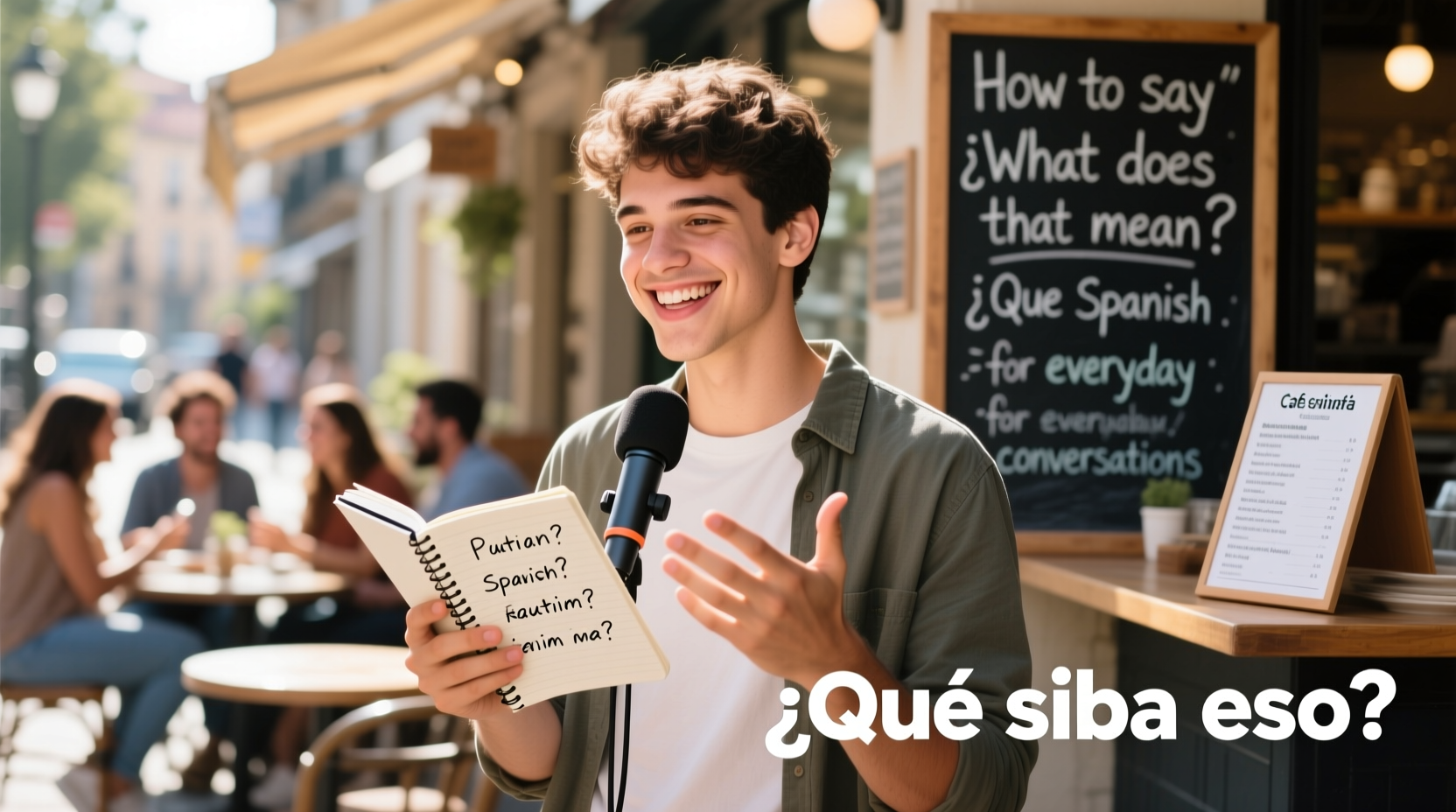Understanding how to ask “What does that mean?” in Spanish is one of the most practical language skills you can develop. Whether you're traveling, watching a Spanish-language film, or speaking with a native speaker, knowing how to clarify unfamiliar words or phrases empowers real communication. It’s not just about translation—it’s about connection. This guide breaks down the essential ways to express this question naturally, with attention to context, tone, and regional variation.
Why This Phrase Matters in Real Conversations

Language learners often focus on memorizing vocabulary and grammar rules, but true fluency emerges when you can navigate uncertainty. Asking for clarification is a sign of engagement, not weakness. In fact, native speakers appreciate when someone makes the effort to understand correctly rather than guessing wrong.
The ability to say “What does that mean?” smoothly allows you to:
- Clarify misunderstandings before they escalate
- Show active listening and cultural respect
- Expand your vocabulary organically through conversation
- Build rapport by demonstrating humility and curiosity
In Spanish-speaking cultures, directness is often balanced with politeness. Knowing the right way to ask for meaning—without sounding abrupt—is key.
Core Translations: How to Say “What Does That Mean?”
The standard translation of “What does that mean?” in Spanish is:
¿Qué significa eso?
Pronounced: *keh sih-GNEE-fih-kah EH-so*
This version works universally across Spanish-speaking countries and is appropriate in both casual and formal settings. However, subtle variations exist depending on region, tone, and specificity.
Common Variations and Their Uses
| Phrase | Literal Translation | When to Use |
|---|---|---|
| ¿Qué quiere decir eso? | What does that want to say? | Softer, slightly more conversational; common in Latin America |
| ¿Qué significa esta palabra? | What does this word mean? | When pointing to a specific term |
| ¿A qué te refieres? | What do you mean? / To what are you referring? | When seeking clarification on an idea or statement |
| ¿Cómo se dice… en español? | How do you say… in Spanish? | When asking for a translation, not meaning |
| ¿Qué es eso? | What is that? | More general; use only when context is clear |
Step-by-Step Guide to Using the Phrase Naturally
Knowing the phrase is one thing; using it confidently in conversation is another. Follow these steps to integrate it seamlessly:
- Listen actively: Pay attention to unfamiliar words during dialogue. Don’t interrupt—wait for a natural pause.
- Signal politely: Begin with a soft interjection like Perdón (Excuse me) or Disculpa (Sorry) to show respect.
- Ask clearly: Use the full phrase: Perdón, ¿qué significa eso?
- Repeat and confirm: After the explanation, repeat the word or phrase and say Ah, entiendo (Ah, I understand) to reinforce learning.
- Use follow-up questions: Ask ¿Puedes usarlo en una oración? (Can you use it in a sentence?) to deepen comprehension.
This process keeps the conversation flowing while showing genuine interest in understanding.
Real Example: A Conversation at a Market in Mexico City
Carlos is shopping for fruit and hears the vendor say chirimoya. He doesn’t recognize the word.
Carlos: Perdón, ¿qué significa eso? ¿Chirimoya?
Vendedor: Es una fruta dulce, de color blanco por dentro y con semillas negras.
Carlos: Ah, ¿como una papaya pero más suave?
Vendedor: Más o menos, sí. ¿Quieres probar un pedazo?
Carlos: ¡Sí, gracias!
By asking clearly and politely, Carlos not only learned a new word but also turned a transaction into a friendly interaction.
Regional Differences and Cultural Nuances
While ¿Qué significa eso? is universally understood, regional preferences shape how people typically ask for clarification.
- In Spain, you might hear ¿Qué quiere decir con…? when discussing abstract ideas.
- In Argentina and Uruguay, ¿Qué es eso? is often used informally, even if technically vague.
- In Colombia, adding porfa (short for por favor) softens the request: ¿Qué significa eso, porfa?
Tone matters as much as wording. A rising intonation and open facial expression signal curiosity, not confusion or criticism.
“Clarity-seeking questions are golden in language learning. They transform passive listening into active mastery.” — Dr. Elena Ruiz, Linguist and Bilingual Education Researcher
Checklist: Mastering the Phrase in Practice
Use this checklist to ensure you’re using the phrase effectively in real-world situations:
- ✅ Memorize the core phrase: ¿Qué significa eso?
- ✅ Practice pronunciation aloud until it feels natural
- ✅ Pair it with polite starters: Perdón, Disculpa, Oye (Hey)
- ✅ Adjust based on context: Use palabra for words, eso for statements
- ✅ Respond appropriately after the explanation: Nod, repeat, thank the speaker
- ✅ Record yourself practicing to refine tone and rhythm
Frequently Asked Questions
Can I use “¿Qué es eso?” instead of “¿Qué significa eso?”?
Yes, but with caution. ¿Qué es eso? translates to “What is that?” and works when pointing to an object. For abstract terms, idioms, or expressions, ¿Qué significa eso? is more accurate and avoids confusion.
Is it rude to ask “What does that mean?” in Spanish?
Not if done politely. Adding por favor or starting with Perdón shows respect. Native speakers generally welcome the opportunity to help and explain. Avoid sounding impatient or dismissive in tone.
How do I ask what a slang word means without offending someone?
Use indirect phrasing: No conozco esa expresión, ¿cómo se usa? (I don’t know that expression, how is it used?). This shows curiosity rather than judgment. In informal settings, you can add Suena interesante (That sounds interesting) to keep the mood light.
Conclusion: Turn Confusion Into Connection
Asking “What does that mean?” in Spanish isn’t just a linguistic necessity—it’s a bridge to deeper understanding. Every time you use ¿Qué significa eso?, you’re not only expanding your vocabulary but also honoring the speaker’s language and culture. Fluency isn’t about never making mistakes; it’s about recovering from them gracefully and learning forward.









 浙公网安备
33010002000092号
浙公网安备
33010002000092号 浙B2-20120091-4
浙B2-20120091-4
Comments
No comments yet. Why don't you start the discussion?